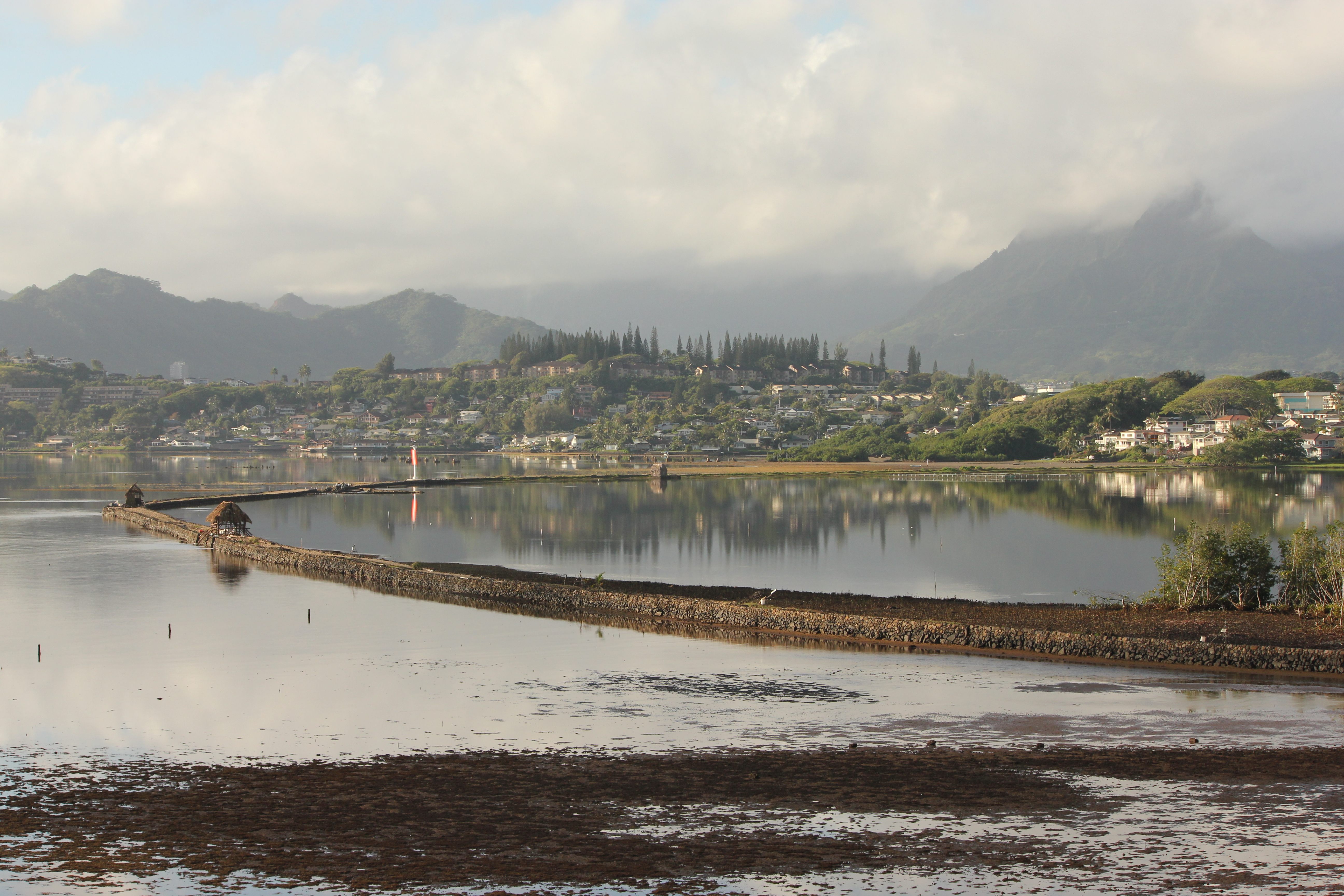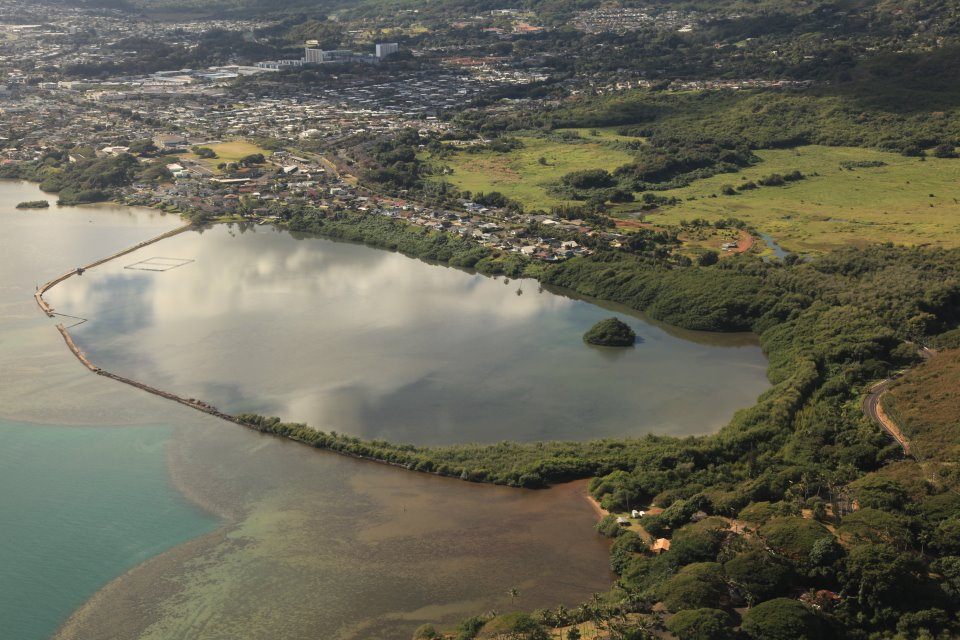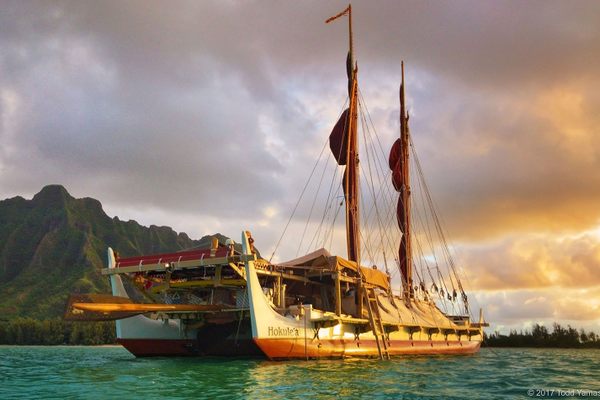The 800-Year-Old Fishpond That’s Still Feeding Hawai‘i
How an O‘ahu community came together to rebuild a fishpond, and revive a traditional farming practice.

During quiet moments in the day, after he’s checked the water quality, given tours, and pulled weeds, Keli‘i Kotubetey pauses to reflect on the hard work and creativity that enabled his ancestors to build the 88-acre He‘eia Fishpond 800 years ago. The word “fishpond” doesn’t do it justice. Hawaiians blocked off the Pacific Ocean by constructing a 1.3-mile long lava rock wall— by hand— then harnessed the unique reservoir for aquaculture.
“I think about how this took hundreds and hundreds of people to build this,” he says, gesturing to the calm waters of the fishpond. “Then a whole other crew of people made food for them each day, and others cared for the kids. That’s community. That’s ingenuity.”
For the past 17 years, Kotubetey has managed and helped rebuild this pond in He‘eia, a small town nestled against the emerald cliffs of the Ko‘olau mountains along O‘ahu’s eastern coast. In 2001, he co-founded Paepae o He‘eia (pronounced “pie-pie oh hay-ee-uh”), a nonprofit dedicated to restoring and preserving the local fishpond. He now serves as the organization’s assistant executive director.
Traditional Hawaiian fishponds were engineered to feed entire communities. At its peak, He‘eia fishpond produced 150 to 300 pounds of fish per acre each year, says Kotubetey– nearly 10 tons from this pond alone. Fishponds also served as important communal gathering places. That community is what inspired Kotubetey and seven of his friends to start the nonprofit. Kotubetey, a Hawaiian born and raised on O‘ahu, says they wanted to share the story of the He‘eia fishpond and traditional Hawaiian aquaculture with others, and involve the community in restoring it, and eventually eating from it, just as their ancestors did.
“This place needed a lot of love,” says Kotubetey, “but it has the potential to feed us again, and not just our body, but our mind and soul.”
When the He‘eia Fishpond was built, such ponds were prevalent in Hawai‘i. Fishponds were usually built along shorelines with shallow reefs. Lava rock walls were assembled to form pools of different shapes and sizes in which fish from the ocean would be trapped, raised, and harvested. Limu (seaweed) was cultivated inside to feed the diverse marine life, including ‘ama‘ama (mullet), moi (pacific threadfin) awa (milkfish), palani (surgeonfish), crab, and more.

The nonprofit’s first task was a big one– 200 feet to be exact. In 1965, a flood destroyed a section of the wall, rendering the pond unusable. Efforts to restore the wall began in 1989, when an aquaculturist named Mary Brooks leased the fishpond and worked to mend the wall with the help of students at the University of Hawaiʻi at Mānoa. Paepae o He‘eia formed to join the endeavor in 2001, but it took 14 years of securing permits, fundraising, and galvanizing locals to begin permanent reconstruction.
“We try to do as much as possible like our ancestors did,” says Kotubetey. For example, he says the rock wall was repaired by hand, including using rocks that were part of the original wall. The staff also conducts traditional ceremonies related to fishponds, and built traditional hale– thatched, open shelters– atop the 12- to 15-foot wide wall. The reconstruction finished in 2015, and they began raising and harvesting the same year.
While only a few traditional fishponds remain in Hawai‘i, there is growing interest across the islands to rebuild these sustainable aquaculture systems for the 21st century. It’s not just a matter of cultural significance; it’s a measure for survival.
Close to 90 percent of Hawai‘i’s food is imported, and it’s estimated that cut off from external supply, only ten days’ worth of fresh produce would be available across the islands. Dependent on imported food, Hawai‘i residents are geographically vulnerable to natural disasters and global events that might disrupt shipping to the area. On O‘ahu, Paepae o He‘eia is doing their part to improve conditions by promoting sustainability.
For the past three years, the nonprofit has focused on fish cultivation, learning the spawning and growth cycles of fish and ensuring the water quality of the fishpond. Paepae o He‘eia has partnered with the University of Hawai‘i at Mānoa to conduct research on the pond.

Each year, approximately 10,000 to 12,000 people visit the fishpond, including school children, college students, vacationers, and local businesses on company retreats. “We want them to have a deep connection [with the fishpond],” says Kotubetey. “An appreciation and recognition that the Hawaiian art of farming is alive and well.”
Ultimately, Paepae o He‘eia’s goal is for the fishpond to feed the community as it once did. Currently, the nonprofit sells crab from the fishpond to local restaurants and offers seasonal public fishing days by permit. While this single pond can’t solve the underlying issue of food security, its positive effects are multitude.
More than the number of sea creatures bred, the success of the He‘eia Fishpond boils down to the enrichment of the community that’s grown up around it– the nonprofit staff who work there daily to restore and preserve it, the children who learn about its history, and the neighbors who spend their free time volunteering in the area.
“We’re keeping this alive by living and breathing Hawaiian fishponds,” says Kotubetey. “These rocks were put in the fishpond wall 800 years ago and we’re touching them. We’re eating the fish. We’re sharing the fishpond with the community.”
The Aloha Spirit brought to you in partnership with OluKai.








Follow us on Twitter to get the latest on the world's hidden wonders.
Like us on Facebook to get the latest on the world's hidden wonders.
Follow us on Twitter Like us on Facebook